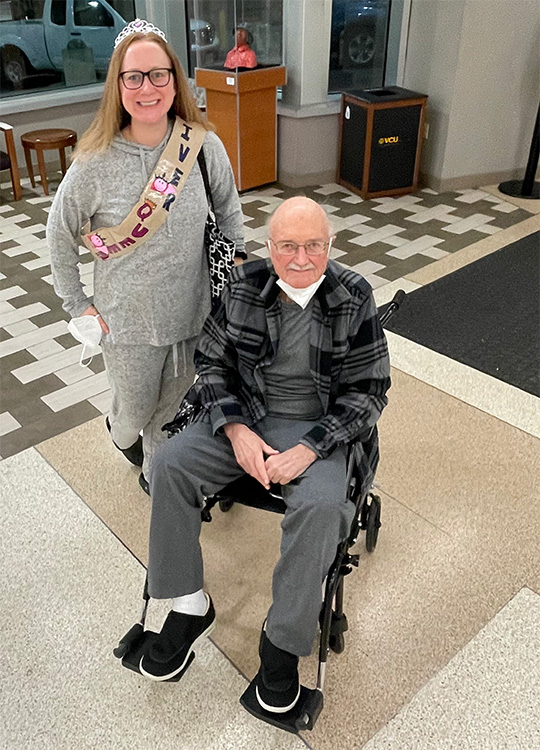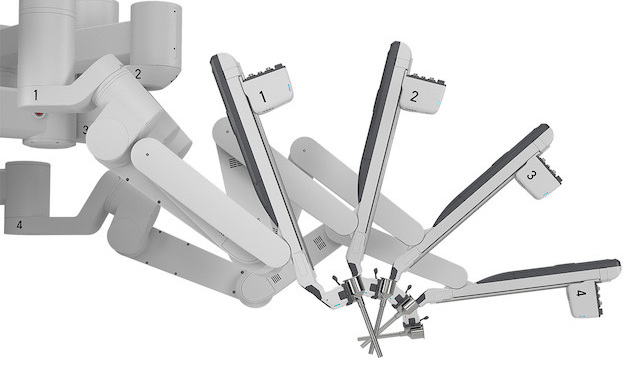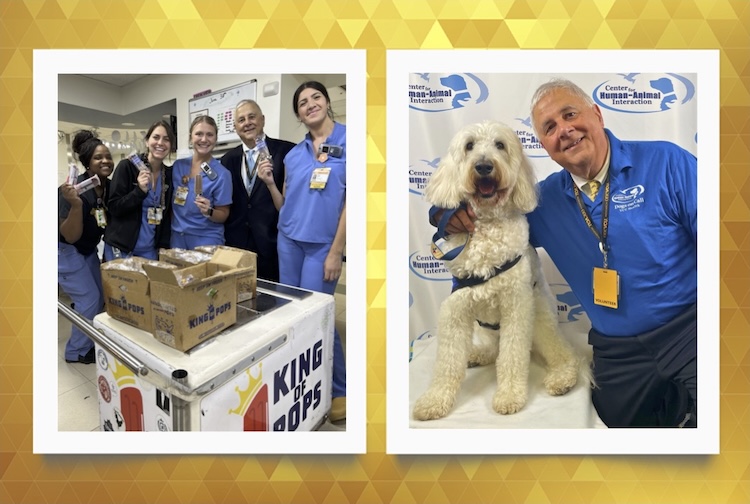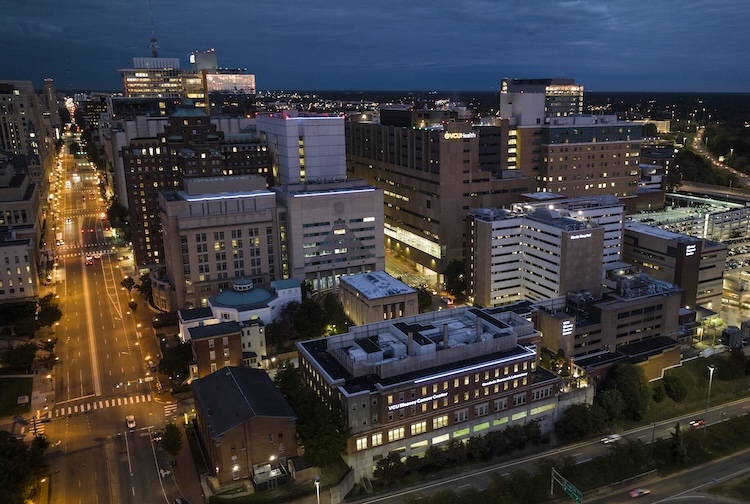VCU Health Hume-Lee Transplant Center taps robot for partial living liver donor transplants
VCU Health plans for first fully robotic liver living-donor transplants in 2023.
March 06, 2023 Seung Duk Lee, M.D., VCU Health Hume-Lee Transplant Center liver transplant surgeon and Vinay Kumaran, M.D., VCU Health Hume-Lee Transplant Center living liver surgical director (VCU Enterprise Marketing and Communications)
Seung Duk Lee, M.D., VCU Health Hume-Lee Transplant Center liver transplant surgeon and Vinay Kumaran, M.D., VCU Health Hume-Lee Transplant Center living liver surgical director (VCU Enterprise Marketing and Communications)
By Jeff Kelley
After learning her blood and anatomy was a match, Katherine Rudolph considered the implications of donating part of her liver to her dad.
Her future, as a mother of two young kids. Her recovery, including weeks of being unable to lift, and time away from teaching high school Spanish. Would it burden her family and husband? And, of course, there was the abdominal scar.
But pushing reluctance and fear aside, she moved forward last summer with the months-long evaluation process.
“Preparing for living donation is a step-by-step process, and VCU absolutely gives you every opportunity to back out,” said Rudolph, noting she was hardened and prepared thanks to a high-risk pregnancy and two babies born via Cesarean. “It becomes more of a mental commitment, so by the time you reach the day of surgery, you're comfortable with it.”
On January 10, the 39-year-old saved the life of her father, Thomas Stennett, who had become sick in early 2022 with non-alcoholic fatty liver disease. In doing so, Rudolph became only the second living donor at VCU Health Hume-Lee Transplant Center to have a portion of her liver removed by the robotic da Vinci Surgical System. The da Vinci allows for less intrusive abdominal surgeries, leading to a speedier recovery and less pain.

Katherine Rudolph (living liver donor) with her father, Thomas Stennett (liver recipient), enjoying a moment together before surgery (Katherine Rudolph)
A robotic surgery pioneer
Robotic surgeries have been performed at VCU Medical Center since 2014, when the health system installed the da Vinci. Hume-Lee established a minimally invasive surgery division in July 2019 under the leadership of Marlon Levy, M.D., Hume-Lee's former director and now VCU Health's interim chief executive.
“The marriage of minimally invasive robotic surgery and organ transplantation is the very kind of leading-edge, forward thinking approach the VCU teams are known for,” Levy said. “We are always looking for ways to bring the future of care to our patients.”
But it was only January when Hume-Lee began using the da Vinci to assist surgeons when removing a portion of a living donor's liver. With a surgeon at the controls, the system's four arms carry a camera scope and instruments into the body via four small punctures to remove a part of the liver before being transplanted into the recipient. The robot is not used on the sick recipient. Due to the procedure's complexity, it is still done by traditional open surgery.
“Young living donors really care about the cosmetic impacts of transplant surgeries, and minimally invasive methods can really help them decide to go forward and give them a faster recovery time,” said VCU liver transplant surgeon Seung Duk Lee, M.D., who's performed hundreds of robotic liver surgeries and has more than a decade of training using robotics. “My experience and training is the reason why we have been able to bring the robot to living liver transplants, and do so safely.”
Robotic assistance is the latest development for the fast-growing living donor liver program, revived in 2019 on the hiring of Vinay Kumaran, M.D., from a health system in India. VCU Health's living liver surgical director, Kumaran has performed more than 800 living donor liver surgeries in his career.
“The robot represents the future of surgery,” the soft-spoken surgeon said, considered by peers to be among the top liver transplant surgeons in the world.
In October, he and Lee traveled to South Korea, where the living-donor transplants are more common than the U.S., and met with surgeons who walked them through “the finer points” of using the da Vinci on a living liver donor, Kumaran says.

The four arms of the Da Vinci XI robot offer surgeons increased precision during the living liver donor's surgery (Da Vinci Xi - Intuitive)
A benefit for surgeons, too
In VCU Health's robotic-assisted liver donor surgery, the da Vinci is controlled by Lee. Kumaran, a more traditionally trained surgeon, assists on the console while a third surgeon operates at the patient's side. Developed and manufactured by Intuitive Surgical Inc., the da Vinci offers surgeons magnification up to 10 times that of the human eye and greater accuracy when moving tissue and making incisions. Its “tremor-filtration” technology eliminates any shaking in an already-steady surgeon's hand to move the robot arms with smooth precision.
Living donation is a focus of growth at Hume-Lee, and key to truly growing patient volume since there's no waiting for a deceased donor, says David Bruno M.D., interim chair for the Division of Transplant Surgery, Department of Surgery at VCU and VCU
Health.
“Paired with our focus on living donation, the robotic system for these surgeries sets us apart from other transplant centers and further solidifies VCU as a destination for patients on the East Coast who are in need of a life-saving liver transplant,” Bruno said, who, like Kumaran and Lee, joined VCU in 2019.
Robotic-assisted surgeries are typically associated with less scarring. At the moment, for living donors, a straight incision in the abdomen remains required to remove the organ, as well as small holes nearby to insert the robotic instruments. But there's less trauma and internal blood loss, and no muscles are cut, aiding recovery and pain. For now, the surgical team must use their hands to separate the liver from the vena cava, a large vein that carries blood to the heart from other areas of the body, before removing it.
VCU plans use the robot for full living donor liver surgeries later this year, which would also move the main incision below the belt line. A fully robotic liver transplantation is complicated. While Lee says he's ready, he wants to take it slow and ensure the entire team is, too. Not all living donors will meet the criteria for using the robot — a lower body mass index and younger candidates are ideal, Kumaran says.
As to Rudolph, the living donor, while she still has an abdominal scar, after just three weeks post-surgery she was out walking with a friend and plans to get back to work prior to her three-months of leave. The surgeons say her speedy recovery would not have been possible without the da Vinci. Her liver has already grown back to its full size, Lee says.
Rudolph also says she was excited, as a curious teacher, to learn she would be one of the first living donors with a robot in the OR.
“Robotics surgery is very impressive, and I'm so honored to have been able to be a part of it. VCU's surgeons, nurses, and the entire transplant team allowed me to give a gift to my father,” Rudolph said. “Being able to see my dad's improvement, both mental and physical, has made it all worth it. He's even talking about taking a trip with my mom. Six months ago, that just wasn't the way he was talking. I'm so appreciative.”




